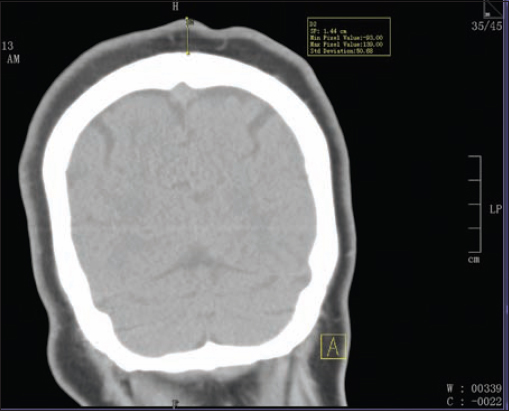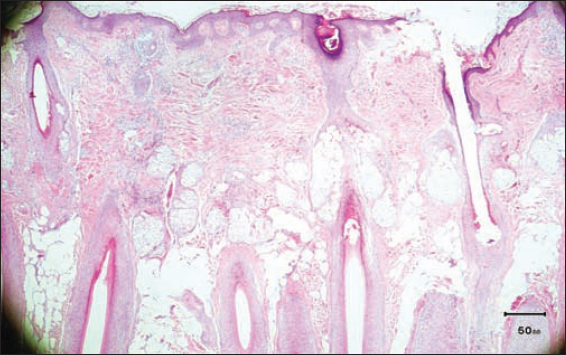Lipedematous scalp: Case report and review of the literature
Salim Al Gaadi1, Sarah Al Godayan2, Iqbal Bukhari2
1Dermatology Department, College of Medicine, Majmaah University, Al Majmaah, Saudi Arabia, 2Dermatology Department, College of Medicine, University of Dammam and King Fahd Hospital of the University, Dammam, Saudi Arabia
ABSTRACT
Lipedematous scalp (LS) is a rare cutaneous disorder of unknown etiology. It is characterized by significant thickening of the subcutaneous layer of the scalp. When it is associated with hair loss it is described as lipedematous alopecia (LA) Lipedematous Alopecia (LA) is a similar disorder associated with hypotrichosis or shortening of hair. Here we report a new case of LS in a 59-year-old Arabic female who presented clinically with a diffuse spongy tender scalp.
Key words:Lipedematous scalp; Alopecia; Hair loss; Scalp
INTRODUCTION
Lipedematous scalp is a rare cutaneous condition of unknown etiology and pathogenesis. It is characterized by thickening of the subcutaneous layer of the scalp. It was first described by Cornbleet in 1935, who reported a 44-year-old black woman who presented with thickening and softening of her scalp [1]. However, the term “lipedematous scalp” was first introduced by Lee in 1994 to differentiate between this condition and others such as lipedematous alopecia [2]. Since then, only 45 cases have been reported in the medical literature.
CASE REPORT
A 59-year-old Arabic female presented to our Dermatology Clinic complaining of thickening of the scalp and headache for the past 2 years. The condition started as a gradual thickening and spongy feeling of her scalp associated with headache. The patient had no history of hair loss or head trauma. Her medical history included Hypertension, Diabetes Mellitus II, Dyslipidemia, Osteoporosis, Osteoarthritis, Cervical spondylosis and Major Depressive Disorder managed medically by the following medications: Aspirin, Pantoprazole, Insulin, Metformin, Escitalopram, and Atorvastatin. There was no history of similar condition in the family. Clinical systemic examination of the patient was unremarkable. Scalp Examination showed normal hair density with no apparent hair abnormality. Scalp skin was normal and hair pull test was negative. On palpation of the scalp it was thick, soft, had a spongy texture without fluctuation and mildly tender all over. There was no pitting of the affected area. No further abnormality was seen in skin, mucous membranes or nails. Complete Blood Count, Liver Function Test, Renal Function Test, Thyroid Function Test and Lipid Profile were within normal limits. Computerized tomography (CT) of the head showed diffuse thickening of the scalp measuring almost 14.4 mm with no brain tissue abnormality (Fig. 1). Scalp incisional biopsy showed normal Epidermis, dermal edema, elastic fibers fragmentation and markedly increased thickness of the subcutaneous fat (Fig. 2). So our final diagnosis was lipedematous scalp. The patient was reassured and a follow up visits to the clinic every 12 weeks was arranged for reevaluation since no effective treatment is available for this condition up to date.
Prior to the study, patient gave written consent to the examination and biopsy after having been informed about the procedure.
DISCUSSION
Lipedematous Scalp is a rare condition of unknown etiology and pathogenesis. It is characterized by thickening of the subcutaneous layer of the scalp. The condition results in a soft, spongy, or doughy quality detected during palpation. When associated with hair loss, it is referred as Lipedematous alopecia. Lipedematous Scalp and Lipedematous alopecia are two entities with similar clinical morphology, imaging features and the slowly progressive course over a period of years. Lipedematous Scalp was first described by Cornbleet in 1935 who reported a 44-year-old black woman with thickening and softening of her scalp which felt like a cotton.1 While Coskey et al in 1961 reported lipedematous alopecia [3]. In 1994, Lee et al reported the second case of lipedematous scalp in a Korean woman [2]. Since then, 45 cases have been reported in the literature [4–16]. Scalp thickening is usually localized at the vertex and occipital areas and may slowly expand to the entire scalp. Patients may have associated symptoms of pain, paresthesias, headache, burning sensations, tenderness, or pruritus. The diagnosis depends upon the clinical features and pathology, which shows thickening of the subcutaneous adipose tissue of the scalp. Both Magnetic Resonance Imaging and head ultrasound scan can be useful to identify and measure the increased scalp thickeness. Different hypotheses have been mentioned in the literature concerning the pathogenesis of lipedematous scalp. There is a debate as to whether leptin plays a role in the development of hyperplasia of subcutaneous fat. This hormone is known to be involved in a long-term feed-back mechanism that regulates fat mass and distribution. Additionally, Yip et al mentioned that leptin plays a role in lipoapoptosis, and serves as a candidate hormone in the pathogenesis of LA and LS [17]. Jone et al suggested adipose metaplasia and the developmental displacement of adipose tissue or possible origin of adipocytes from the wall of dermal vessels in the course of degenerative changes in dermal connective tissue in a manner similar to hamartomatous lesions [18]. Martin et al reported that the presence of edema of the thickened adipose tissue and dilated lymphatic vessels suggest that lymphangiectasia may be responsible for hair loss because it is found only in those patients with lipedematous scalp and alopecia [19]. While some authors relate alopecia to compression of the superficial blood capillaries by the increased volume of the subcutaneous fat layer within the thickened scalp. It seems that both mechanisms play a role in hair loss associated with some cases having lipedematous scalp. Besides, headache may result from pressure on dermal nerves caused by dermal edema and thickening. To date no guidelines for the treatment of Lipedematous scalp or Lipedematous alopecia have been reported. Systemic and intralesional steroids have been utilized with no clear effect. Yip et al reported a successful treatment of Lipedematous alopecia by surgical intervention with de-bulking and scalp reduction [17].
CONCLUSION
Lipedematous scalp and lipedematous alopecia are two rare dermatological disorders with unknown etiology and pathogenesis with no consistent systemic comorbidity. Up to date, only 45 cases have been reported in the world and our case is an addition to this group of patients. Future studies are needed to reveal the pathogenesis and treatment of this rare disorder.
Consent
The examination of the patient was conducted according to the Declaration of Helsinki principles.
REFERENCES
1. Cornbleet T, Cutis verticis gyrata?Lipoma?Arch Dermatol Syphilol 1935; 32: 688.
2. Lee JH, Sung YH, Yoon JS, Park JK, Lipedematous scalpArch Dermatol 1994; 130: 802.
3. Coskey RJ, Fosnaugh RP, Fine G, Lipedematous alopeciaArch Dermatol 1961; 4: 619.
4. Bukhari I, Muhlim FA, Hoqail RA, Hyperlipidemia and lipedematous scalpAnn Saudi Med 2004; 24: 484-5.
5. Cornelia S, Müller L, Niclou M, Vogt T, Pföhler C, Lipedematous diseases of the scalp are not separate entities but part of a spectrum of lipomatous lesionsJDDG 2012; 10: 501-7.
6. Mansur AT, Yasar S, Aydingoz IE, Goktay F, Ozdemir N, Sungurlu F, Colocalization of lipedematous scalp and nevus lipomatosus superficialis: a case reportJ Cutan Pathol 2007; 34: 342-5.
7. El Darouti MA, Marzouk SA, Mashaly HM, El Nabarawi EA, Abdel-Halim MR, El Komy MM, Lipedema and lipedematous alopecia: report of 10 new casesEur J Dermatol 2007; 17: 351-2.
8. Curtis JW, Heising RA, Lipedematous alopecia associated with skin hyperelasticityArch Dermatol 1964; 89: 819-20.
9. Kane KS, Kwan T, Baden HP, Bigby M, Woman with new onset boggy scalpArch Dermatol 1998; 134: 499-502.
10. Fair KP, Knoell KA, Pattern JW, Rudd RJ, Greer KE, J Cutan Pathol2000; 27: 49-53.
11. Light AE, Histologic study of human scalps exhibiting various degrees of non-specific baldnessJ Invest Dermatol 1949; 13: 53.
12. Bridges AG, von Kuster LC, Estes SA, Lipedematous alopeciaCutis 2000; 65: 199-202.
13. Ikejima A, Yamashita M, Ikeda S, Ogawa H, A case of lipedematous alopecia occurring in a male patientDermatology 2000; 201: 168-70.
14. Tiscornia JE, Molezzi A, Hernandez MI, Kien MC, Chouela EN, Lipedematous alopecia in a white womanArch Dermatol 2002; 138: 1517-8.
15. High WA, Hoang MP, Lipedematous alopecia: an unusual sequela of discoid lupus, or other co-conspirators at work?J Am Acad Dermatol 2005; 53: 2 suppl 1S157-61.
16. Wylie GR, Clark C, Roditi G, Lipoedematous scalpJ Eur Acad Dermatol Venereol 2009; 23: 208.
17. Yip L, Mason G, Pohl M, Sinclair R, Successful surgical management of lipoedematous alopeciaAustralas J Dermatol 2008; 49: 52-4.
18. Jones EW, Marks R, Pongsehirun D, Naevus superficialis lipomatosus. A clinic pathological report of twenty casesBr J Dermatol 1975; 93: 121-33.
19. Martin JM, Monteagudo C, Montesinos E, Guijarro J, Llombart B, Jordá E, Lipedematous scalp and lipedematous alopecia: a clinical and histologic analysis of 3 casesJ Am Acad Dermatol 2005; 52: 152-6.
Notes
Source of Support: Nil,
Conflict of Interest: None declared.


Comments are closed.